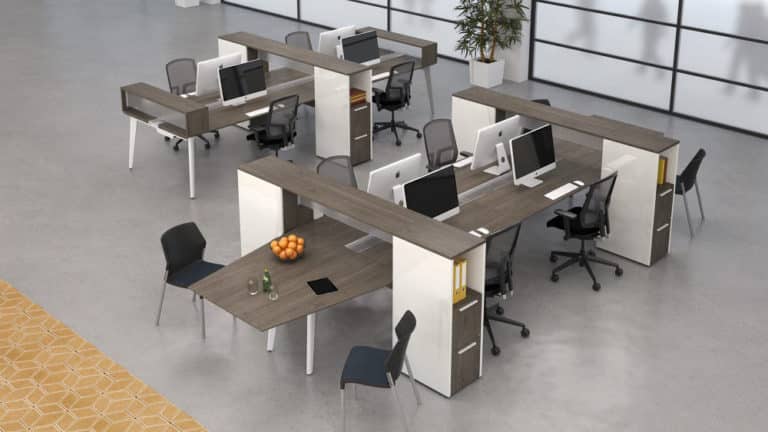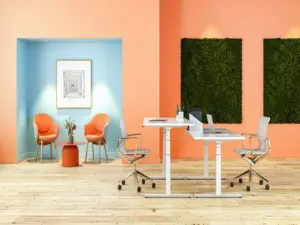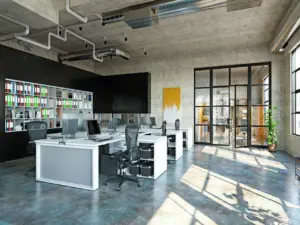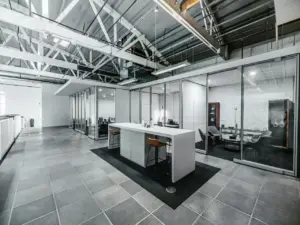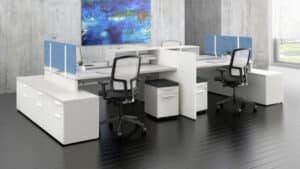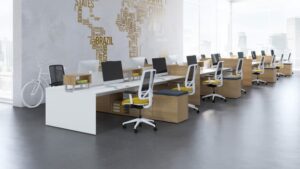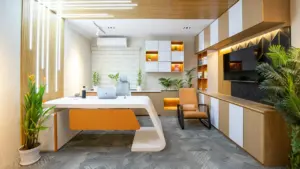Office furniture in modern office design is a key element in creating functional and inspiring workspaces, but its impact goes beyond aesthetics and productivity. Choosing sustainable office furniture not only supports environmental responsibility but also promotes long-term durability and timeless design. This article explores practical tips and furniture options that prioritize sustainability, functionality, and employee well-being. With insights into office furniture, ergonomic furniture, the role of a corporate interior designer, and the value of commercial interior design services, this guide will help you create a workspace that’s both eco-friendly and efficient.
1. Ergonomic Desks
Ergonomic desks are a must-have for modern office design. Adjustable-height desks reduce strain on the body by allowing employees to switch between sitting and standing positions, promoting better posture and circulation. Look for desks made from reclaimed wood or certified sustainable materials to ensure environmental responsibility.
Desks with modular designs are another excellent choice, as they can adapt to changing needs over time. By investing in ergonomic furniture with durable construction in your modern office design, you reduce waste and create a healthier work environment.
2. Office Chairs
Office chairs are essential for any workspace, but sustainability should be a priority when selecting them. Ergonomic chairs made from recycled or renewable materials provide both comfort and eco-friendliness. Look for chairs with adjustable features like lumbar support, seat height, and armrests to accommodate diverse user needs.
Chairs with replaceable parts are also a sustainable option, as they allow for easy repairs instead of full replacements. This approach aligns with the principles of sustainable office furniture by reducing waste and extending product life cycles.
3. Modular Furniture
Modular office furniture is ideal for creating adaptable modern office design that can evolve with your business needs. From workstations to storage units, modular designs are built to be reconfigured or expanded over time, minimizing the need for new purchases.
Materials like bamboo or FSC-certified wood make modular furniture even more sustainable. A skilled corporate interior designer can help integrate modular pieces into your workspace seamlessly, ensuring both functionality and style.
4. Reclaimed Wood Furniture
Reclaimed wood is a popular choice for sustainable office furniture due to its durability and unique aesthetic. Desks, tables, and shelving units made from reclaimed wood add character to your workspace while reducing demand for new timber.
Incorporating reclaimed wood into your office design also supports eco-friendly practices by giving new life to materials that would otherwise go to waste. This timeless approach aligns perfectly with the goals of modern office design.
5. Energy-Efficient Lighting Solutions
While not strictly furniture, lighting plays a crucial role in ensuring a sustainable modern office design. LED lighting fixtures integrated into desks or shelving units consume significantly less energy than traditional options while providing ample illumination.
Furniture pieces with built-in lighting features can further enhance energy efficiency while maintaining a sleek appearance. Collaborating with commercial interior design services ensures these elements are incorporated effectively into your workspace.
6. Multi-Functional Furniture
Multi-functional furniture is an excellent way to optimize modern office design while reducing material use. Examples include desks with built-in storage compartments or seating that doubles as filing cabinets.
By choosing multi-functional pieces, you minimize the need for additional furniture, reducing both costs and environmental impact. These versatile solutions are particularly valuable in smaller offices or shared workspaces.
7. Upholstered Furniture with Sustainable Fabrics
When selecting upholstered office furniture like chairs or sofas, prioritize fabrics made from recycled materials or organic fibers such as cotton or wool. Low-VOC (volatile organic compound) finishes are another important consideration, as they improve indoor air quality by reducing harmful emissions.
Sustainable upholstery not only benefits the environment but also enhances employee wellness—a key focus of any thoughtful corporate interior designer.
8. Storage Solutions
Efficient storage is essential for maintaining an organized workspace, but it doesn’t have to come at the expense of sustainability. Look for filing cabinets, bookshelves, or lockers made from recycled metal or wood certified by organizations like the Forest Stewardship Council (FSC).
Smart storage solutions that maximize vertical space can reduce clutter while minimizing the need for additional furniture pieces. Integrating these options into your office layout demonstrates a commitment to both functionality and sustainability.
9. Collaborative Furniture
Collaboration is at the heart of many modern workplaces, making collaborative furniture an essential component of modern office design. Choose conference tables made from eco-friendly materials like reclaimed wood or bamboo, paired with ergonomic seating options that prioritize comfort during long meetings.
Breakout spaces can feature modular seating arrangements crafted from recycled materials, creating informal areas where teams can brainstorm while staying true to sustainable principles.
10. Outdoor Office Furniture
Outdoor workspaces offer employees a chance to recharge in natural surroundings while staying productive. Weather-resistant tables and chairs made from recycled plastic or sustainably sourced teak are perfect for creating outdoor meeting areas or relaxation zones.
Incorporating outdoor spaces into your office layout not only promotes wellness but also aligns with biophilic design principles—a hallmark of effective commercial interior design services.
Key Takeaways
- Sustainable office furniture prioritizes durability, eco-friendly materials, and adaptability to reduce waste.
- Ergonomic furniture enhances employee comfort while supporting long-term health.
- Modular designs offer flexibility for evolving workspace needs.
- Reclaimed wood adds timeless elegance while promoting environmental responsibility.
- Multi-functional pieces maximize space efficiency without compromising style.
- Upholstered furniture with sustainable fabrics improves indoor air quality.
- Collaborative spaces benefit from eco-friendly materials that encourage teamwork.
- Outdoor office furniture connects employees with nature while supporting wellness initiatives.
- Partnering with commercial interior design services ensures seamless integration of sustainable solutions into your workspace.
Final Thoughts
Sustainable office furniture is about making choices that benefit both people and the planet. By prioritizing durability, eco-friendly materials, and timeless designs over fleeting trends, businesses can create a modern office design that inspire productivity while supporting environmental responsibility.
If you’re looking to transform your office into a sustainable haven of creativity and efficiency, Studio Forma is here to help! As Toronto’s leading corporate interior designer, we specialize in creating innovative workspaces that balance modern aesthetics with employee wellness. Visit us today to start designing an office that’s built to last!
Frequently Asked Questions (FAQ):
Why is ergonomic furniture important in sustainable office design?
Ergonomic furniture supports employee health by reducing physical strain during long working hours while offering durability that minimizes waste over time.
How does modular office furniture promote sustainability?
Modular designs allow businesses to reconfigure or expand their layouts without purchasing new pieces, reducing material consumption and waste.
What role does a corporate interior designer play in creating sustainable workspaces?
A corporate interior designer ensures that every element of the workspace—from layout to materials—aligns with sustainability goals while enhancing functionality and aesthetics.
